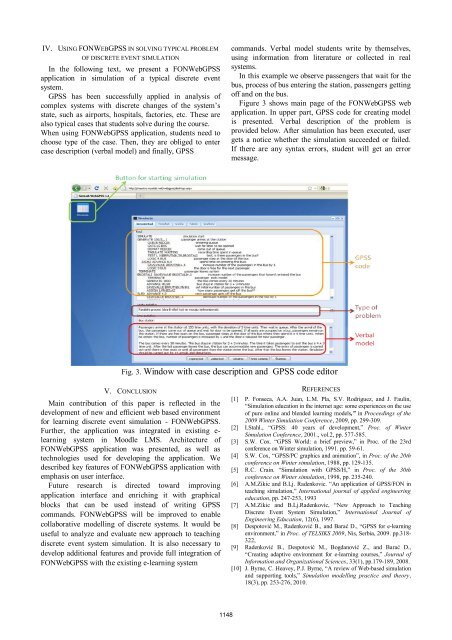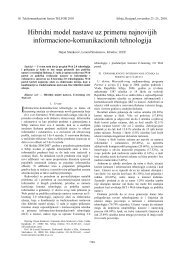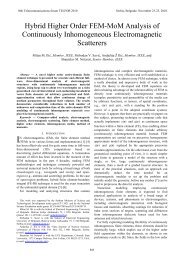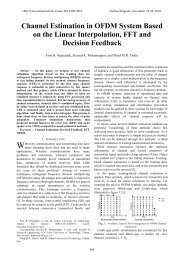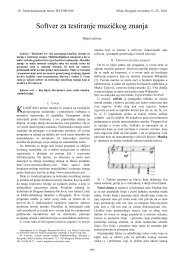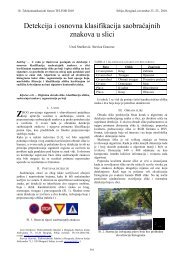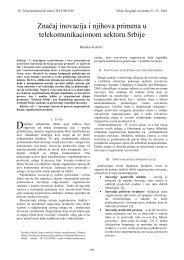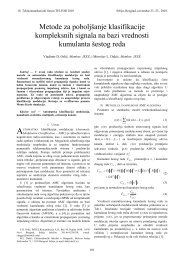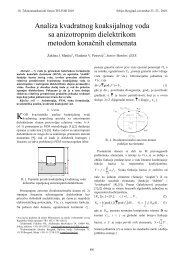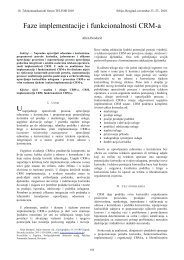TELFOR 2006 - 18. telekomunikacioni forum TELFOR 2010 - Telfor
TELFOR 2006 - 18. telekomunikacioni forum TELFOR 2010 - Telfor
TELFOR 2006 - 18. telekomunikacioni forum TELFOR 2010 - Telfor
Create successful ePaper yourself
Turn your PDF publications into a flip-book with our unique Google optimized e-Paper software.
IV. USING FONWEBGPSS IN SOLVING TYPICAL PROBLEM<br />
OF DISCRETE EVENT SIMULATION<br />
In the following text, we present a FONWebGPSS<br />
application in simulation of a typical discrete event<br />
system.<br />
GPSS has been successfully applied in analysis of<br />
<br />
state, such as airports, hospitals, factories, etc. These are<br />
also typical cases that students solve during the course.<br />
When using FONWebGPSS application, students need to<br />
choose type of the case. Then, they are obliged to enter<br />
case description (verbal model) and finally, GPSS<br />
commands. Verbal model students write by themselves,<br />
using information from literature or collected in real<br />
systems.<br />
In this example we observe passengers that wait for the<br />
bus, process of bus entering the station, passengers getting<br />
off and on the bus.<br />
Figure 3 shows main page of the FONWebGPSS web<br />
application. In upper part, GPSS code for creating model<br />
is presented. Verbal description of the problem is<br />
provided below. After simulation has been executed, user<br />
gets a notice whether the simulation succeeded or failed.<br />
If there are any syntax errors, student will get an error<br />
message.<br />
Fig. 3. Window with case description and GPSS code editor<br />
V. CONCLUSION<br />
Main contribution of this paper is reflected in the<br />
development of new and efficient web based environment<br />
for learning discrete event simulation - FONWebGPSS.<br />
Further, the application was integrated in existing elearning<br />
system in Moodle LMS. Architecture of<br />
FONWebGPSS application was presented, as well as<br />
technologies used for developing the application. We<br />
described key features of FONWebGPSS application with<br />
emphasis on user interface.<br />
Future research is directed toward improving<br />
application interface and enriching it with graphical<br />
blocks that can be used instead of writing GPSS<br />
commands. FONWebGPSS will be improved to enable<br />
collaborative modelling of discrete systems. It would be<br />
useful to analyze and evaluate new approach to teaching<br />
discrete event system simulation. It is also necessary to<br />
develop additional features and provide full integration of<br />
FONWebGPSS with the existing e-learning system<br />
1148<br />
[1]<br />
REFERENCES<br />
P. Fonseca, A.A. Juan, L.M. Pla, S.V. Rodriguez, and J. Faulin,<br />
Simulation education in the internet age: some experiences on the use<br />
of pure online and blended learning models, in Proceedings of the<br />
2009 Winter Simulation Conference, 2009, pp. 299-309.<br />
[2] I.Stahl., GPSS: 40 years of Proc. of Winter<br />
[3]<br />
Simulation Conference, 2001., vol.2, pp. 577-585.<br />
S.W. Cox. GPSS World: a brief preview Proc. of the 23rd<br />
conference on Winter simulation, 1991. pp. 59-61.<br />
[4] S.W. CoxGPSS/PC graphics and animation in Proc. of the 20th<br />
conference on Winter simulation, 1988, pp. 129-135.<br />
[5] R.C. Crain. Simulation with GPSS/H Proc. of the 30th<br />
conference on Winter simulation, 1998, pp. 235-240.<br />
[6] A.M.Zikic and B.Lj. Radenkovic. An application of GPSS/FON in<br />
teaching simulation International journal of applied engineering<br />
education, pp. 247-253, 1993<br />
[7] A.M.Zikic and B.Lj.Radenkovic, New Approach to Teaching<br />
<br />
Engineering Education, 12(6), 1997.<br />
International Journal of<br />
[8] and GPSS for e-learning<br />
environment, Proc. of TELSIKS 2009, Nis, Serbia, 2009. pp.318-<br />
322,<br />
[9] and <br />
Creating adaptive environment for e-learning courses, Journal of<br />
Information and Organizational Sciences, 33(1), pp.179-189, 2008.<br />
[10] J. Byrne, C. Heavey, P.J. Byrne, A review of Web-based simulation<br />
and supporting tools, Simulation modelling practice and theory,<br />
18(3), pp. 253-276, <strong>2010</strong>.


